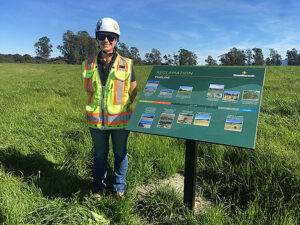By Jondi Gumz
Can you name a major employer in the Tri-County area, still owned by the family of the founder, and celebrated 125 years in business this year?
No, it’s not the Santa Cruz Beach Boardwalk.

Yes, it’s Graniterock, a leader in the construction industry, employing nearly 1,000 people, including 100 at the quarry.
When I got an invitation from Shanna Crigger, my former Santa Cruz reporter colleague, to join a media tour of the quarry, I said yes.
This is one place I had never seen during my 33 years as a reporter.
The quarry is a vast space — 1,000 acres — in the middle of nowhere, just outside Aromas, stretching into San Benito, Monterey and Santa Cruz counties.
As you enter, there’s a sign with the number of days without an employee injured and unable to work: 54.
In the quarry, your drive on the left for safety reasons.
Graniterock’s motto is “Safety above all else.”
We did have to wear hard hats, safety goggles and reflective vests.
Railroad surveyors working along the banks of the Pajaro River discovered the granite deposit, which at first was named for Judge Logan.
“Mother Earth gave us this vein of granite,” said Keith Severson, Graniterock’s director of community relations, leading the tour. “We’re serving 70 to 100 jobs a day.”
Those jobs could be the base of a new road, riprap for a seawall — or for a dam.
Wilson and his partner saw the potential of the property after rock was supplied to Southern Pacific Railroad to build track, and incorporated Granite Rock Company in 1900.
The site is on the San Andreas Fault.
It turns out California’s other major vein of granite is in the Sierra Nevada, not as convenient for building in the San Francisco Bay Area.
Everything is huge: The 4-story Krupp crusher from Germany, the trucks hauling heavy loads, the tires.
A conveyor belt a mile long carries rock from the pit — 120 feet below sea level — to the processing facility.
Heavy loads can be shipped by rail, 100 rail cars a day, saving wear and tear on highways.
Jacquie Borges, an environmental engineer for Graniterock, showed off an area where mining no longer takes place, a reclamation project required by the state.
At this location, no rock is visible, just thick green native grasses taking over a 22-acre hillside next to 15,000 solar panels that provides 60% of the power to the mining operation.
This $15 million solar farm was completed in 2022, inspired by environmental activists.
The native grasses come from Graniterock’s greenhouse in Aromas.
Graniterock offers employees a career, a place to learn new skills with pay to support a family.
Hollister High School, 19 miles away, offers a building and construction pathway in its Career Technical Education.
What keeps Graniterock going for 125 years?
Severson said, “The people.”
And the granite vein is expected to serve the community for another 100 years.